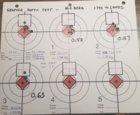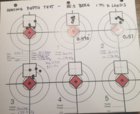Ned Ludd
Silver $$ Contributor
David - it goes around and comes around. I like the idea of helping someone else out if it's a topic I have any experience with. Many others have freely shared information here at Accurate Shooter that was helpful to me, so it all works out well. In fact, I just got back my original .223 Rem for shooting the 90s with a couple new barrel cut and am going to start woking up loads. If the 90s don't pan out for some reason, I may need to try the 85.5s.
The 1% variance in OAL was what I was thinking about in the previous response about its effect on BC. If OAL variance has a direct and linear effect on BC, with a 1% OAL variance you're only talking about a change in BC in the 3rd decimal place. I would estimate that most of us would have difficulty in clearly distinguishing a change in BC of less than around 5% or so. A change equal or larger than that is fairly easy to discern using drop at 300 yd or farther. For bullets we typically use with G7 BCs in the .200 to .350 range, I would expect BC variance in the third decimal place for any Lot# to be the norm, from sources including dimensional variance, slight differences in the meplats, slight differences in the core, folds on the nose, and probably a few other sources I haven't even considered.
Sorting bullets is all well and good; I do it myself by OAL as described above for pointing purposes. But there comes a point when the effort that goes into sorting by every parameter known to man is a waste as Monte alluded to above. Beyond a certain point, most people can't ever shoot the difference. Taken to the extreme, you could theoretically sort into sub-groups by enough different parameters that you'd end up with a single bullet in each sub-group. Not so good when you need 20 rounds plus sighters from the same sub-group for each match . I try to keep the sorting steps to a minimum, and select methods for sorting things that are relatively simple and fast (i.e. measuring with calipers, weight determination with a balance, etc.).
. I try to keep the sorting steps to a minimum, and select methods for sorting things that are relatively simple and fast (i.e. measuring with calipers, weight determination with a balance, etc.).
The 1% variance in OAL was what I was thinking about in the previous response about its effect on BC. If OAL variance has a direct and linear effect on BC, with a 1% OAL variance you're only talking about a change in BC in the 3rd decimal place. I would estimate that most of us would have difficulty in clearly distinguishing a change in BC of less than around 5% or so. A change equal or larger than that is fairly easy to discern using drop at 300 yd or farther. For bullets we typically use with G7 BCs in the .200 to .350 range, I would expect BC variance in the third decimal place for any Lot# to be the norm, from sources including dimensional variance, slight differences in the meplats, slight differences in the core, folds on the nose, and probably a few other sources I haven't even considered.
Sorting bullets is all well and good; I do it myself by OAL as described above for pointing purposes. But there comes a point when the effort that goes into sorting by every parameter known to man is a waste as Monte alluded to above. Beyond a certain point, most people can't ever shoot the difference. Taken to the extreme, you could theoretically sort into sub-groups by enough different parameters that you'd end up with a single bullet in each sub-group. Not so good when you need 20 rounds plus sighters from the same sub-group for each match


















